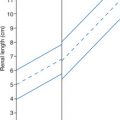Chapter 15. Uterus, Placenta, Umbilical Cord, and Fluid
| Uterus, Placenta, Umbilical Cord, and Fluid | |||
|---|---|---|---|
| Sonographic Finding(s) | Clinical Presentation | Differential Diagnosis | Next Step |
Hypoechoic to hyperechoic rounded structure in uterine wall; single or multiple Does not change in size during sonogram May distort contour of uterus May distort uterine cavity | Asymptomatic or Pregnancy is large for dates by palpation Possible pain, contractions, vaginal bleeding | Leiomyoma (fibroid) Uterine contraction Placenta previa | Document location and size; may enlarge during pregnancy Evaluate location relative to placenta and cervical os May cause malposition of uterus or fetus or spontaneous abortion |
| Cystic mass in maternal adnexa | Asymptomatic or Pelvic pain/discomfort | Persistent corpus luteum cyst Dermoid Dilated ureter Mucinous/serous cystadenoma Paraovarian cyst | A corpus luteum cyst should regress by 15 weeks’ gestation |
Single or multiple hypoechoic areas or lesions noted within the placenta or may be subchorionic Swirling blood may be seen with 2D imaging | Asymptomatic Labs: elevated AFP may be noted | Placental lakes Venous lakes Intervillous thrombus Fibrin deposits Chorioangioma Gestational trophoblastic disease Placental abruption | Placental lakes may change size during exam because of uterine contractions Increased risk of placental insufficiency Increase gain settings to visualize swirling blood (color Doppler imaging not helpful) |
| Anechoic tubular structures posterior to placenta, between basal plate and myometrium | Asymptomatic | Prominent marginal veins (retroplacental complex) Retroplacental hemorrhage | Use color Doppler imaging to confirm blood flow within structures |
Cervix length is shorter than normal with EV or transperineal imaging (length <25.0 mm at or before 24 weeks’ gestation) Funneling appearance of internal os (>50% of cervical length) Bulging membranes may be noted | Asymptomatic History of preterm delivery, multiple gestation, or cervical surgery (cone, LEEP, etc.) Possible vaginal bleeding or leakage of amniotic fluid | Incompetent cervix Overly distended maternal urinary bladder; lower uterine contraction (either may mimic cervical funneling or obscure shortened cervix) | Evaluate cervix immediately after patient is supine If risk factors are present or cervix appears short, apply fundal pressure; document length of cervix with/without fundal pressure Use transperineal technique if bleeding, leakage of fluid, or cervical dilation are noted |
| Edge of the placenta is noted very near internal cervical os | Asymptomatic | Low-lying placenta | False positive because of Braxton-Hicks contraction or fibroid in lower uterine segment |
Fetus is completely surrounded by and is free floating in amniotic fluid AFI >25.0 cm Single pocket >8.0 cm Placenta may appear thinned | Uterus measures large for dates Maternal diabetes | Polyhydramnios | Associated with esophageal or duodenal atresia, skeletal and CNS anomalies, fetal hydrops |
Visualization of fetal anatomy is limited or impossible Little or no amniotic fluid noted AFI <5.0 cm Single pocket <2.0 cm | Uterus measures small for dates Loss or leaking of amniotic fluid (PROM) Known polyhydramnios
Stay updated, free articles. Join our Telegram channel
Full access? Get Clinical Tree


| ||

